Culture
Key Difference Between The British Royal Family Weddings
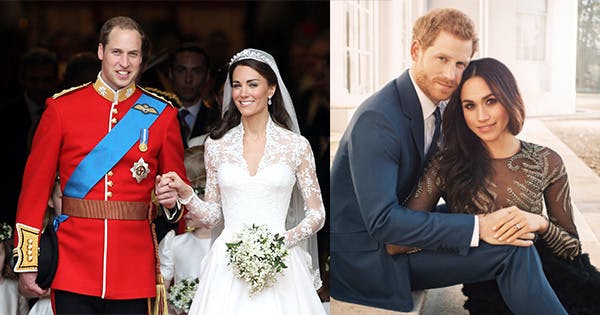
While in the past a British royal wedding would happen once a decade, we’ve been fortunate enough to see two of them in the same decade due to the brothers, William and Harry. Interestingly, the two ceremonies and their run-up have shown some very interesting similarities and contrasts in how they were prepared, occurred and developed. These are events of national pride for the British, so all the stops come out when one occurs, which again has been generational for the most part. So having two in the same short time span has provided detail attention folks a smorgasbord of comparisons to work with, as well as what some of the thinking might have been in the preparations.
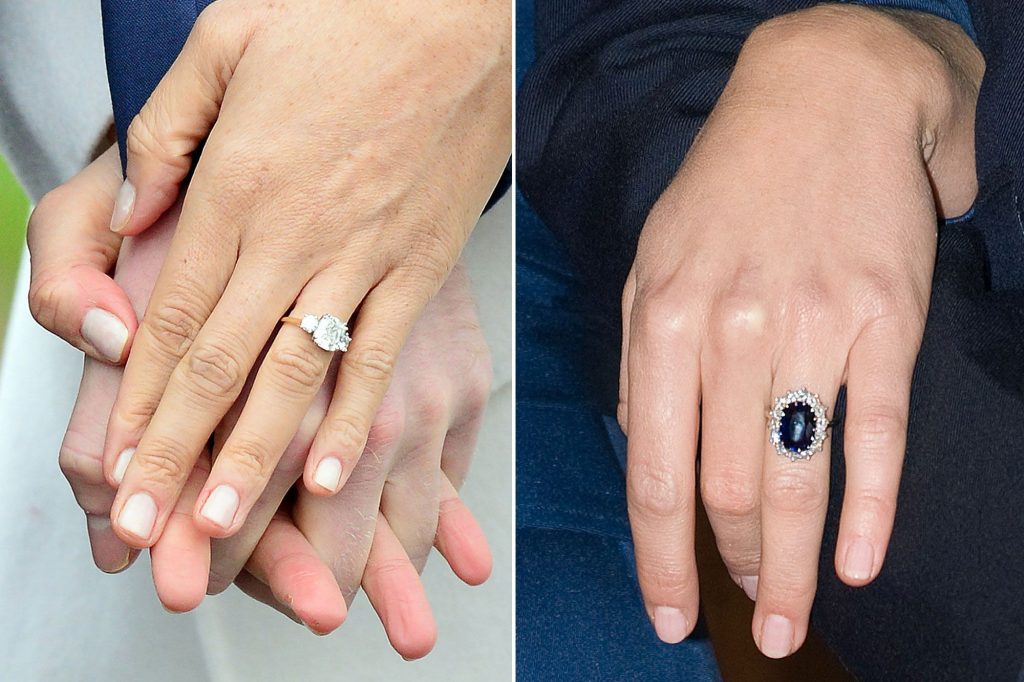
The Rings
For both sons of Princess Diana who have grown up in the media since an early age thanks to the popularity of their late mother, the rings chosen for their engagements were extra special. Both came from Princess Diana’s ring collection, tying their marriage and another generation to her history and past in doing so. William’s ring given to Kate Middleton produced an oval blue setting in a 12-carat ring with a perimeter of small diamonds as the accent. Harry’s ring to Meghan Markle was a modification of his mother’s ring, including two diamonds from Diana as well as new stone Harry added with an attachment to Botswana. This new stone significance noted where the couple first really attached to each other.

The Wives
Kate Middleton, hands down, is a true-blood Briton by family, lineage, name and practice. There couldn’t have been a better fit for William with regards to British aristocracy expectations, and she was a night and day difference as a partner versus the antics that happened a generation before with his uncle, Andrew. The British high society circles were no stranger to Kate; her family traveled through all the right schools and reputations due to their established wealth and connections. It was inevitable that the two would cross paths. The surprise was that they developed a relationship and connected.
Meghan Markle provided Harry a self-established wife of renown and success through her own means by acting. Already famous and rising her own entertainment star, Markle was quite adept at managing the paparazzi and acting world and stood her own in any business environment, particularly given how successful she was already. Harry found a match that married him on even terms, irrespective British norms and social rules.
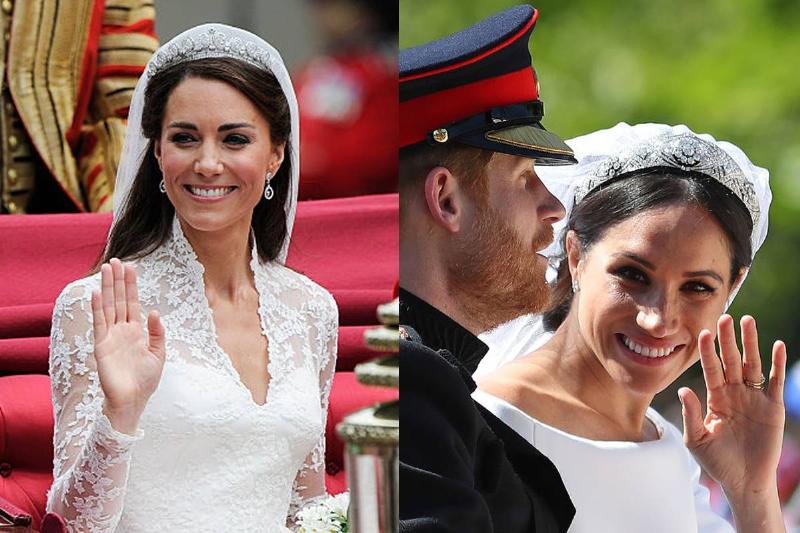
Crowd Engagement
During the wedding ceremonies the wives-to-be are expected to engage with the crowd and onlookers but with a reserved perspective. Kate Middleton practiced the age-hold British practice of the stiff back, at attention sitting in the carriage, waving with a stiff hand and smiling for the cameras. Megan Markle handled the cameras and audience just fine, being a veteran in front of the camera, but she added a bit of personality, making some of her waves a bit more genuine and connected with specific onlookers she would see, particularly children.

The Father-in-Law
Prince Charles has had a long, troubled history with British weddings given his fiasco with Princess Diana and then partnering up with Camilla Parker afterwards. For years there was a lot of enmity thrown in his direction for how he was perceived to have treated Diana. However, in practice, he has been close with both his sons, and Charles was clearly present at both weddings in full military dress and uniform for his elder son, and a business suit for the younger son. Camilla was at Charles’ side for both events.
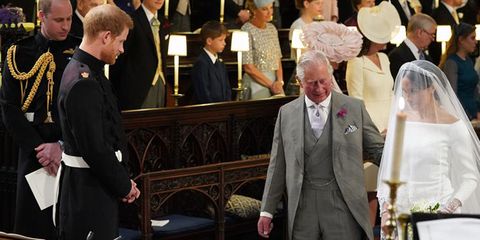
The Walk Down the Aisle
In standard British décor, Kate Middleton was walked down the aisle with her father. The classic look was traditional, historical and followed all the expected customs of British aristocracy. The classic long wedding dress train was in full display as well. Megan Markle, on the other hand, ended up walking down the aisle by herself. Her father was unable to make the even at the last moment due to sickness. To make up for the awkward exposure in front of everyone, it was Prince Charles himself who met Markle halfway down the aisle and walked her the rest of the way to Harry. In some small respects, Charles may have been trying to make up for his past doing so.

Dressed for the Wedding Reception
Megan Markle was very clearly not going to be normal British aristocracy right from the start, that was well known. The differences started to appear right after the wedding ceremony, as her choice of reception dress was very notable. Utilizing a design by Stella McCartney, Markle was dressed to the nines with a gown that hung off her neck and showed her shoulders and upper back. She was a look, and Harry was beaming. Kate Middleton, on the other hand, opted for an Alexander McQueen design with a long gown and white fur coif on the top as a mini-jacket.

The Wedding Kiss
As a symbolic end to the official wedding ceremony, the audiences around Buckingham Palace are always gifted with the proud husband kissing his new wife for the crowd. Both princes honored the Britons as such. William was in his bright red military suit and kissed the new Duchess of Cambridge on the balcony overlooking the crowds. Harry chose his uniform as a stark black style, and kissed the new Duchess of Sussex right outside of St. George’s Chapel after the ceremony ended. The crowds loved it both times.
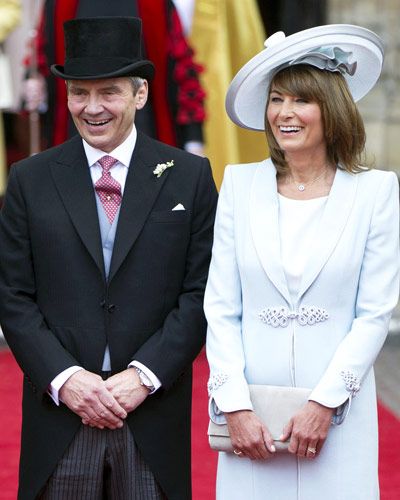
Royal Audience Members
Kate Middleton’s parents attended both weddings, as did much of the British aristocracy and upper titled members. The first was obvious, for the wedding of their daughter, and the second was out of decorum being part of the royal family now by extension. In both cases Micheal and Carole Middleton were dressed to the nines in dashing formal wear, but Michael had made a point to wear a tophat to his daughter’s wedding when outside, and both parents were beaming during that event.
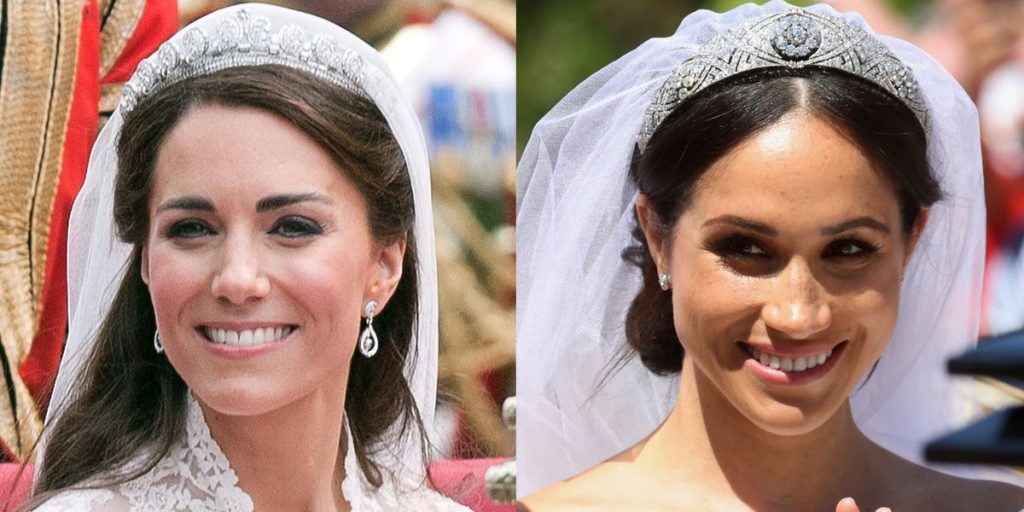
The Wedding Dress Tiaras
No wedding dress is complete without the veil and the tiara to keep it in place. Believe it or not, the veil is a historical tie back to ancient times and dress. While the west might be very separated from the Middle East, the veil is clearly a historical connection back to ancient times carried through to modernity via custom and tradition. Kate Middleton’s tiara was designed by Cartier and came from Queen Elizabeth. Meghan Markle’s tiara was also provided by the Queen, but her’s was a Bandeau design. Markle added a change and had a sapphire placed in the middle for her specific look.
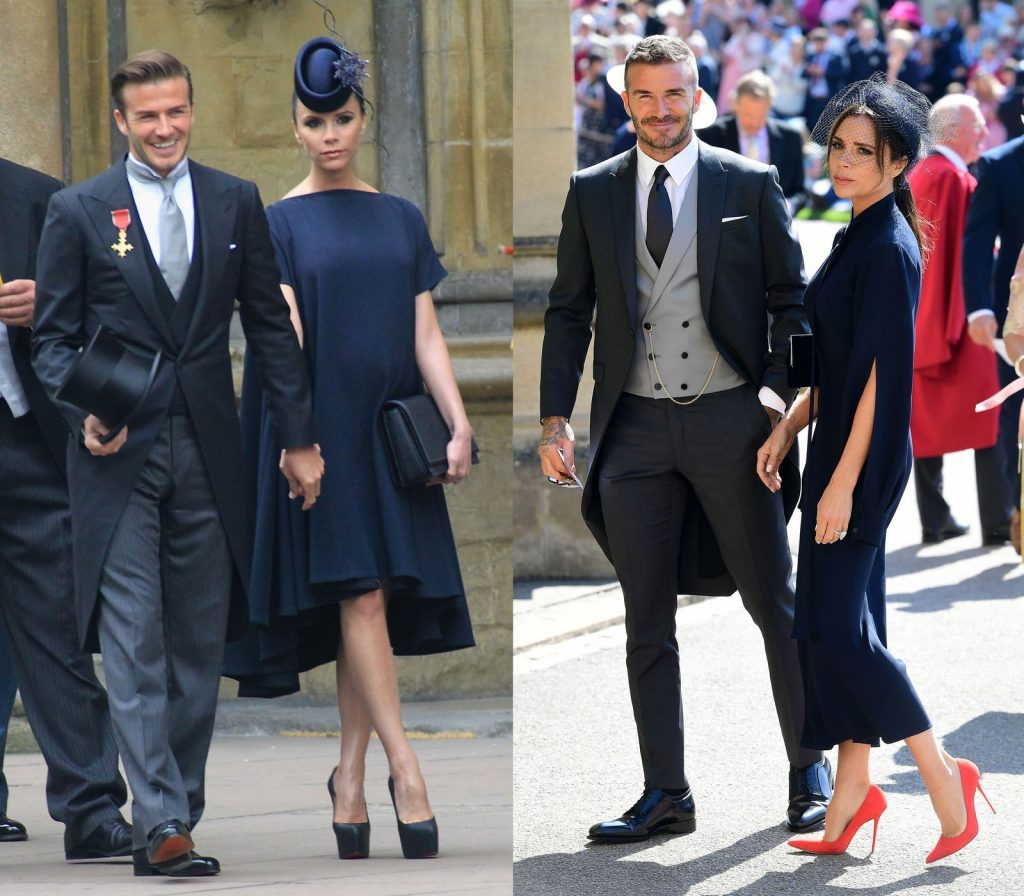
Interesting Guests: The Beckhams
Soccer star David Beckham and his celebrity-singer wife Victoria (formerly Posh Spice) were in full attire at both weddings. For the first one David made a point to wear his medal while at the second it was absent. Victoria Beckham was in sleek dresses for both affairs. In making a social point during the second wedding, the couple donated their suit and dress to charity after the event to help a specific non-profit with the proceeds that would sure come from the clothes and their recent history.
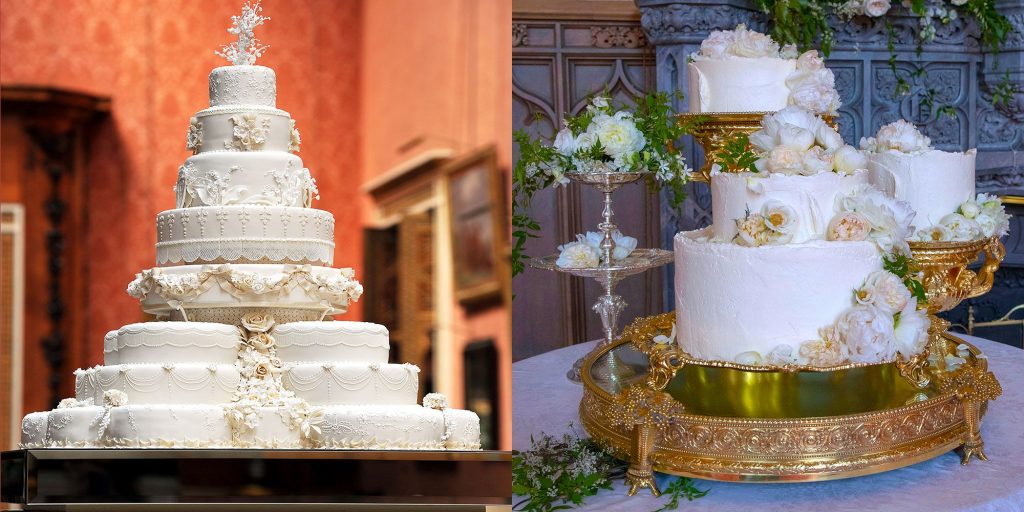
The Wedding Cake
One of the big differences between the events that everyone noticed as the wedding cake style. For William and Kate’s wedding, their cake was a stacked design with a towering white set of flowering sprigs on the top. Harry and Meghan’s cake, on the other hand was broken up and displayed on multiple tiers with white roses and flowers everywhere. These cakes were common with each other in that they were extremely expensive. William and Kate’s cake cost a total of $160,000 while the same for Harry and Meghan ran a cool $75,000.

The Wedding Bouquets
From a distance, both brides’ bouquets seemed to be almost the same, but up close the differences are noticeable. Kate Middleton’s bouquet was designed independently and provided to her. Meghan Markle’s bouquet, on the other hand, included flowers chosen by Harry specifically, making hers far more personal for the event. Both bouquets were designed by professional florists and finished for the weddings with intricate details included.
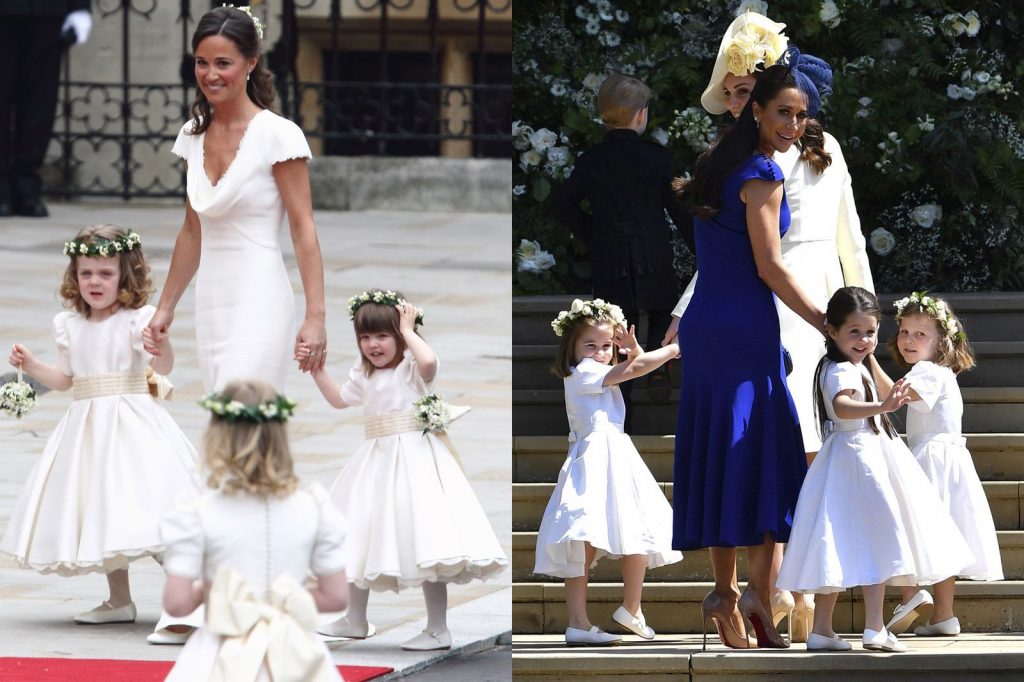
The Entourage
For Kate Middleton, her wedding entourage would be none other than her sister Pippa, which was almost put into some jeopardy with some issues in the run-up to the wedding. Fortunately, it all blew over despite what some of the paparazzi were hoping for otherwise. Pippa became Kate’s maid of honor with two small wedding girls. Meghan Markle opted for four wedding girls, no maid of honor, and two page boys. A good number of Meghan’s friend attended, but none were picked for the maid of honor role. They may have all breathed a sigh of relief from the stress.
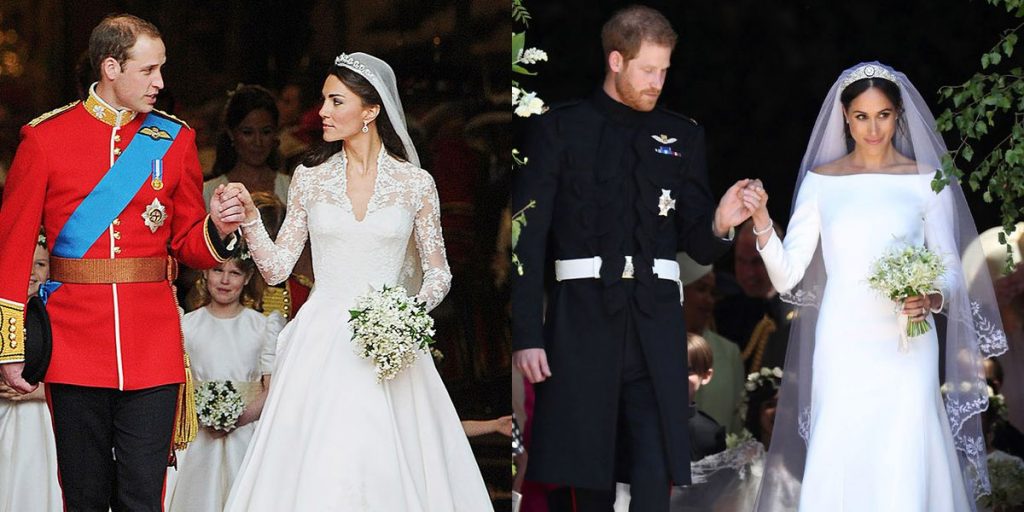
The Grooms Themselves
William was a standout in his red military uniform with a blue sash. His official rank, Colonel, was in full display, and the red symbolized the Irish Guards. This was significant since no royal family member had married with a red uniform since 1973. Prince Harry chose a very dark blue military uniform indicative of his membership in the Blues and Royals, his rank of Major was displayed, but officially he is also a Captain General in the Royal Marines. Both carry their military service beyond honorific titles; William spent years as a helicopter pilot and Harry saw action in Afghanistan.
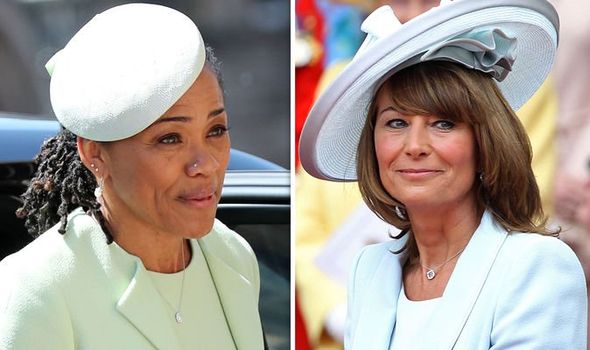
The Mothers of the Bridges
Both mothers were subtle and muted dresses and outfits to focus the attention on their daughters being married. Carole Middleton was in a pale blue matching outfit designed by Catherine Walker. It matched her complexion perfectly as she seemed more smiles than Kate was. Doria Ragland, Meghan’s mother, showed up in an Oscar de la Rente outfit, attending solo after flying in from Los Angeles to attend. She too beamed for her daughter and the big day.
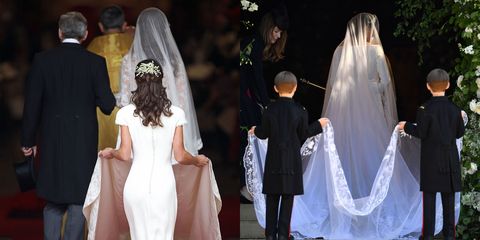
The Wedding Dress Train
Kate Middleton’s dress included a solid material long train that was reminiscent of that which Princess Diana had during her wedding. Meghan Markle’s train was extensively long as well, but hers was a sheer style that was transparent and see through to some extent, making it unique and different.

Wedding Reception Locations
The first son’s wedding reception was held at Buckingham Palace, following tradition and custom. Since the second’s son wedding did not require so much rigidity, Harry and Meghan’s reception was held at St. George’s Hall located in Windsor Castle. Notably absent was a face that had been close to Harry in prior years. Chelsy Davy attended the wedding of William and Kate but had just separated from Harry at the time. However, she did not attend the first reception and was not invited to the second one for Harry and Meghan.
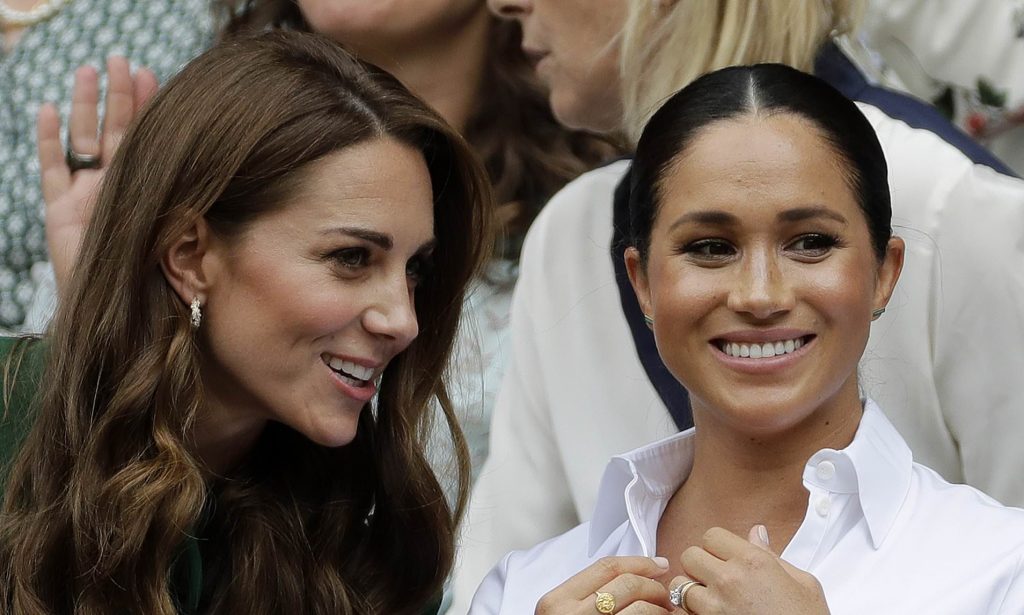
The Cost of a Royal Wedding
Again, the royal weddings are major national event for the British, which also means the government hosts the cost of the weddings as well. The money comes back with tremendous revenues in broadcasting licensing and tourism, so it’s not a loss in the long run, but up front there is a serious cash flow going out the door. William and Kate’s wedding totaled $34 million. Some seven years later, Harry and Meghan’s wedding ran far more even with fewer guests, totaling a whopping $55 million.

The Queen
Queen Elizabeth II was very much enjoying the affairs and the weddings and dressed up for the occasion. In her first grandson’s wedding she wore a muted light lemon cream style outfit that was very formal and traditional. In her second grandson’s wedding, however, the Queen decided to go to town and chose a lime green outfit with a purple feather accent on the hat and her blouse. Many felt the Queen was trying something different for a change and getting over her stuffy ways for a moment.
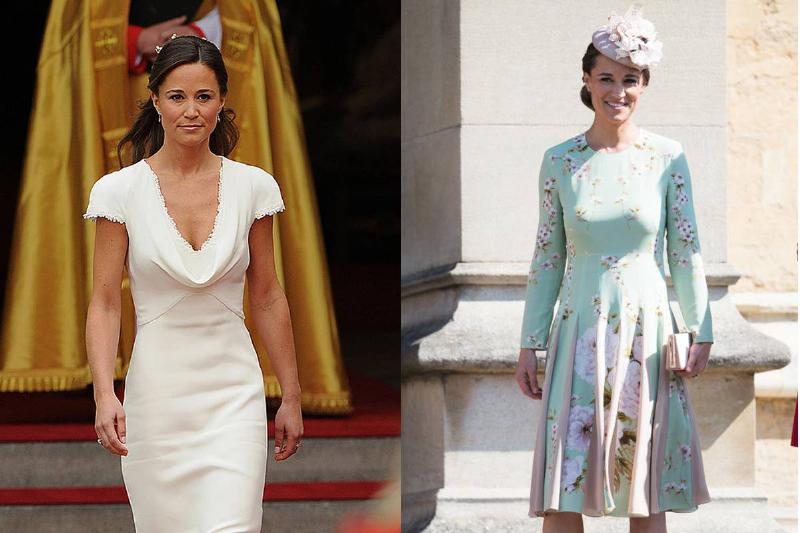
Pippa’s Approach
For the first wedding, the eyes were all on Kate and her sister as both of them were part of the wedding train, Pippa being the maid of honor. However, for the second wedding Pippa got to be part of the formal audience instead, with less stress, and clearly enjoying herself a lot more. For the formal role, she was in a plain off-white, sleek gown so that the focus of attention was on her sister. When not managing her’s sister’s wedding train, Pippa found herself managing the two wedding girls for good measure. For the second wedding, Pippa wore a light green floral arrangement and matching hat, enjoying a Spring event in the sun. There were no children to manage and definitely no worries associated with where to stand in the right place anymore.

The Bridal Earrings
Kate Middleton’s royal earrings hung as a tear drop design that was quite noticeable. Meghan Markle chose as tighter ensemble, with her earrings worn without any dangle and far more conservative in look.

The Crowds
There was no question that William and Kate’s wedding brought out half the country. It was the crowning achievement of the royal family after years of bad press and scandal that just wouldn’t seem to go away. With a new generation led by William, the country pulled out the stoppers and had a huge bash celebrating the first prince’s wedding for their future king and queen.
Harry and Meghan’s wedding brought out a smaller crowd, but one that was still substantial around Windsor castle. The location of St. George’s Chapel limited the bigger crowds from forming as it was far more off the beaten path than Buckingham Palace. Unlike downtown London, where most of the 2,000 or so people congregated for the first wedding with flags down the main avenue, Windsor Castle did not accommodate such entrances as well. Given both crowd control, distance and security needs, the second wedding naturally made the crowds smaller, although quite a few dedicated fans still showed up and made themselves present and known in adulation of the marrying couple.

Prince Phillip
Last but not least, Prince Phillip was in attendance for both of his grandsons’ weddings. For William’s wedding Prince Phillip was in full military attire, showing off his own red Grenadier Guards uniform in full decoration. For Harry’s wedding, however, Prince Phillip was far less militaristic, wearing a dark Oxford tuxedo instead. Recent health issues likely contributed to Prince Phillip going for less of a production in his wedding attire, as time was taking a toll on the man seven years later.
Culture
India Reigns Supreme in Big Cat Conservation: Celebrating Success and Setting New Goals
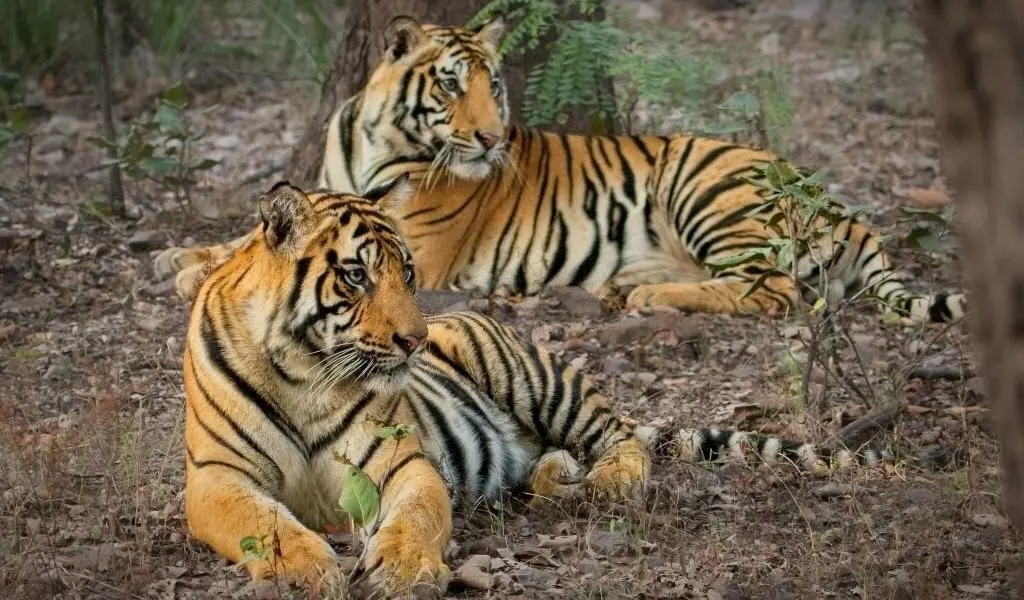
India is now recognized as a global leader in the conservation of big cats, boasting control of 75% of the world’s wild tiger population, serving as the sole sanctuary for Asiatic lions, and celebrating the successful reintroduction of cheetahs. Additionally, populations of leopards and snow leopards in the country are witnessing promising growth. This impressive conservation narrative is getting a further boost with the formation of the International Big Cat Alliance (IBCA), which was officially launched by the Union Cabinet with a funding of Rs 150 crore till 2028. The IBCA secretariat will be headquartered in India, underlining the country’s pivotal role in global big cat conservation efforts.
The Genesis and Goals of the International Big Cat Alliance
Prime Minister Narendra Modi unveiled the IBCA in April 2023 in Mysuru, marking the 50th anniversary of Project Tiger. The alliance aims to foster international collaboration for the preservation of seven key big cat species: lions, tigers, leopards, cheetahs, snow leopards, jaguars, and pumas. India houses five of these species, excluding only the jaguar and puma. This alliance encompasses 96 big cat range countries and various conservation and scientific organizations, demonstrating a robust international effort to protect these vulnerable and endangered species.
Asiatic Lion Conservation: A Beacon of Success
The only wild population of Asiatic lions resides in Gujarat’s Gir National Park and its surroundings, with the population reaching 674 in 2020, up from 523, marking an unprecedented growth rate of 28.87%. This species, once on the brink of extinction with numbers as low as 20, has seen remarkable recovery thanks to dedicated conservation efforts beginning well before India’s independence and formally initiated by the Indian Forest Service in 1965. Plans are now underway to relocate some lions to the Badra Wildlife Sanctuary to manage overpopulation risks in Gir.
Project Tiger: A Legacy of Triumph
India celebrates the resounding success of Project Tiger, initiated in 1973 to reverse the dire decline of tigers from around 40,000 at independence to below 2,000 by 1970 due to rampant hunting and poaching. Today, India hosts 3,682 tigers, a nearly 24% increase from 2018, spread across 53 reserves. This success story is a result of stringent anti-poaching laws, habitat conservation, and local community engagement, positioning India as a leader in tiger tourism and conservation compared to other Asian nations.
The Return of the Cheetah
India has reintroduced cheetahs to its fauna, with initial translocations from Namibia and South Africa to Madhya Pradesh’s Kuno National Park. This reintroduction project has faced challenges, but the recent birth of cubs and a survival rate meeting the project’s early goals highlight its potential success. The program aims to not only revive the cheetah population but also to foster ecological tourism and local economic development.
Leopard and Snow Leopard: Thriving Against Odds
Leopards, despite being the smallest of the large cats in India, are flourishing with a population increase from 12,852 in 2018 to 13,874 in 2022. This growth is credited to comprehensive conservation efforts across various states. Similarly, the elusive snow leopard, primarily found in high-altitude regions of the Himalayas, has been systematically surveyed, revealing a stable population that underscores India’s commitment to preserving its natural heritage.
India’s proactive and successful conservation initiatives for big cats not only enhance biodiversity but also bolster local communities and economies, reinforcing the nation’s commitment to maintaining the delicate balance between human progress and environmental stewardship.
Culture
South Africa Plans to Stop Lion Breeding for Hunts

South Africa announced its plan on Wednesday to gradually stop the breeding of lions for hunting. This decision aims to end the business that has been criticized for a long time. This business involves raising big cats so that rich hunters, who pay a lot of money, can hunt them. These hunters often take parts of the lions, like their heads or skins, as trophies to keep.
The South African government had already shown its desire to stop lion breeding for hunts in 2021. A special group has been working on this matter for two years. Environment Minister Barabara Creecy, during a news conference in Cape Town, said that this group suggested shutting down the industry. This includes stopping the breeding of lions, keeping them captive, or selling anything obtained from captive lions.
Lion breeders have two years to stop their activities voluntarily and find a different business to do before this new rule is enforced. Even though this plan has met with resistance from the industry, which makes a lot of money, the government approved it recently. However, it’s not yet an official law.
This step is taken as more people, especially in Western countries, are against trophy hunting. Efforts to stop trophy imports are gaining support in the United States, Australia, and some European countries. Kamalasen Chetty, who leads the special group, mentioned that the lion breeding industry is big and complicated. It has a long history but doesn’t fit with the latest international trends or changes in local conservation policies.
Animal rights organizations estimate that there are between 8,000 and 12,000 lions on around 350 farms in South Africa. These groups often criticize the way these animals are kept. In contrast, there are only about 3,500 wild lions, as reported by the Endangered Wildlife Trust, an organization based in South Africa.
Culture
Research Finds That Birds Can Be Polite
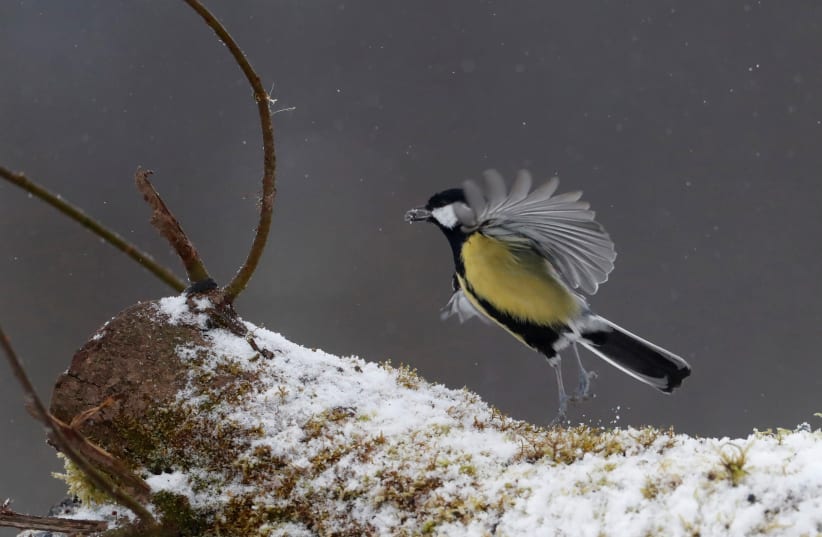
Did you know that birds can be polite, just like humans? Researchers have found that the Japanese tit, a small bird found in Japan, has a unique way of showing politeness through its wing gestures. This fascinating discovery gives us a glimpse into the complex world of bird communication.
At the University of Tokyo, Professor Toshitaka Suzuki and his team studied these birds and made some amazing discoveries. They noticed that when a pair of Japanese tits arrives at their nest box with food, they don’t rush in. Instead, they wait on nearby perches. What happens next is intriguing: one bird flutters its wings toward the other, as if to say, “After you.” This gesture is like holding the door open for someone, showing respect and care.
The Japanese tit, scientifically known as Parus minor, is not just any bird; it’s known for its intelligence and complex behaviors. Professor Suzuki, who has been studying these birds for over 17 years, found that they use specific calls and even combine these calls into phrases, much like how we form sentences. This shows how advanced their communication skills are.
In their study, published in the journal Current Biology, the researchers observed that these wing-fluttering gestures happened mainly between mates and were a clear sign for one to enter the nest before the other. Interestingly, it was usually the female that made the gesture, inviting the male to go first.
This behavior has led scientists to think about how gestures evolved in the animal kingdom. Just like humans developed gestures by using their hands more when they started walking on two legs, birds might have developed gestures by using their wings while perching.
The research on the Japanese tit is part of a larger effort to understand how animals communicate, not just with sounds but also with physical movements. This could help us learn more about how language and communication developed, even in humans.
So, the next time you see birds, think about the complex and polite ways they might be communicating right in front of your eyes!
Culture
Volunteers and Camels Team Up to Restore Mojave Desert’s Joshua Trees
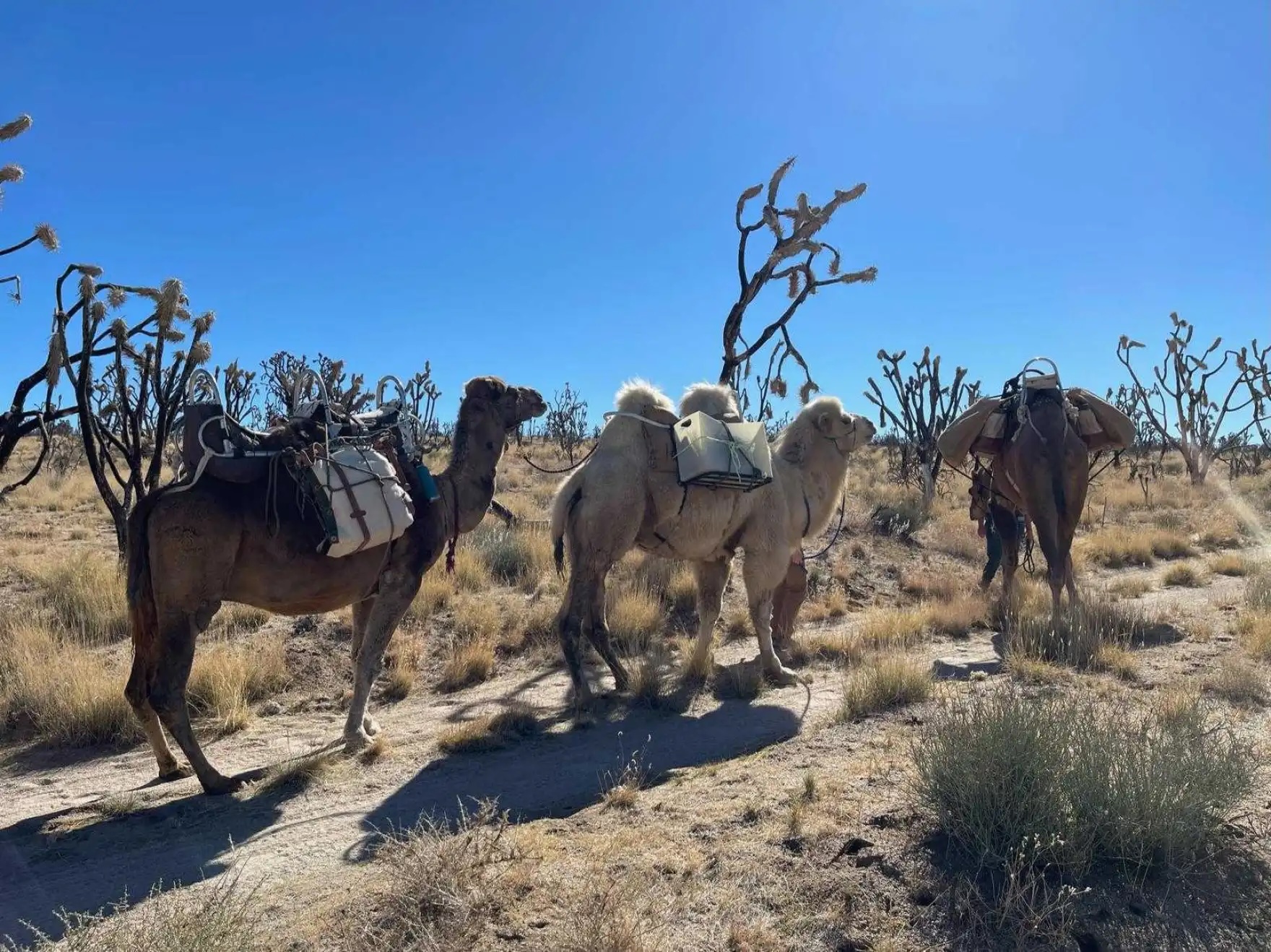
The Mojave Desert, with its vast, arid landscape, is home to the iconic Joshua tree. These unique trees have a fascinating history, once coexisting with Giant Ground Sloths during the ice age and now relying on rodents for their slow dispersal. However, a devastating wildfire in 2020 burned a significant portion of the desert, including many Joshua trees, posing a challenge for their restoration.
“Joshua trees seeds don’t spread very quickly,” explained Debra Hughson, deputy superintendent at the Mojave National Preserve. “They don’t move very fast or they don’t move very far with just small mammals around.” Despite these challenges, scientists were determined to help the Joshua trees recover, especially in areas like Cima Dome, where their survival could be crucial in the face of climate change.
To accelerate the recovery process, Hughson and her colleagues decided to plant Joshua tree seedlings in a more spaced-out pattern in the Dome’s burn scar. This approach aimed to distribute seed sources and promote the recovery of the entire area. However, the rugged terrain made it difficult for volunteers to reach the designated planting spots, requiring hours of hiking.
To address this challenge, the team came up with a unique solution — using camels to transport the seedlings and water into the wilderness. “Prehistoric camels were in the Mojave Desert, and the camels came through in 1857,” explained one of the volunteers, highlighting the historical connection between camels and the region. The camels, led by Herbie, Sully, and Chico, have been instrumental in carrying out these restoration efforts since 2021.
“Our goal is to protect natural systems and natural ecosystems — all the plants, all the animals, but then some animals and some plants wind up being just a little bit more ‘charismatic’ than other ones,” said Hughson, emphasizing the importance of charismatic species like the Joshua tree in garnering support for conservation efforts.
Through the dedication of volunteers and the help of these remarkable camels, the Mojave Desert’s Joshua trees are slowly making a comeback, offering hope for their future in this challenging environment.
Culture
Apes’ Playful Teasing Behavior Mirrors Human Playfulness
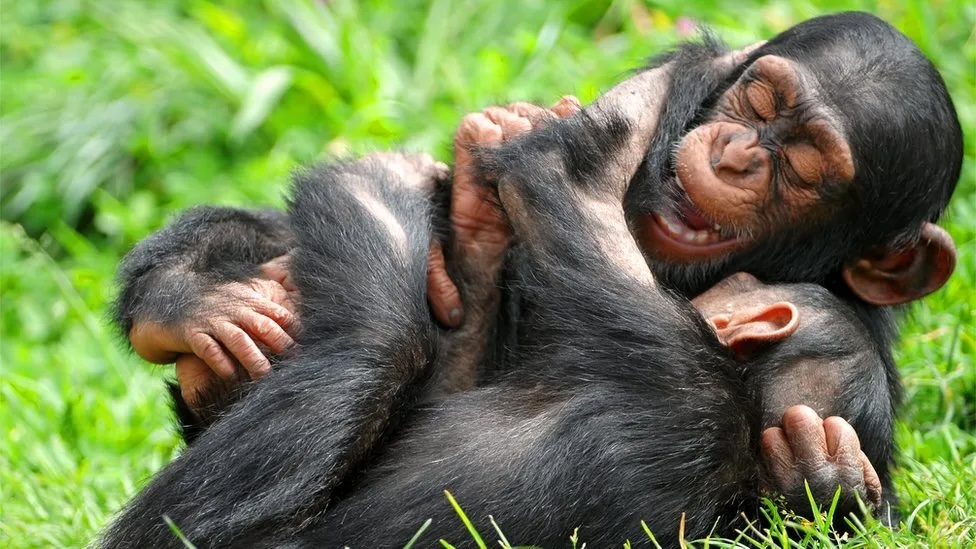
Did you know that apes like to tease and prank each other, just like humans do? Researchers have found that chimpanzees, bonobos, gorillas, and orangutans engage in playful teasing behavior, such as poking, tickling, body slamming, hair pulling, and waving objects in front of faces. This behavior is usually one-sided, with one ape trying to get a reaction from another.
In a study published in the journal Proceedings of the Royal Society B Biological Sciences, researchers analyzed 75 hours of video footage of apes at the San Diego Zoo in California and the Leipzig Zoo in Germany. The apes studied were between the ages of 3 and 5. The researchers observed 284 instances of teasing behavior, with 129 meeting the criteria for playful and provocative behavior. They identified 18 different teasing behaviors.
Professor Erica Cartmill of UCLA, who led the study, said that teasers often waved or swung body parts or objects in front of the other ape, hit or poked them, stared closely at their face, disrupted their movements, pulled their hair, or performed other behaviors that were hard to ignore.
The researchers believe that playful teasing and joking may have evolved in human ancestors around 13 million years ago. This behavior has implications for the study of emotion, humor, and pretense, and the researchers hope that their study will inspire further research into playful teasing in other species to better understand its evolution.
-

 OMG6 years ago
OMG6 years agoA Couple Gave Birth to the Most Beautiful Twins Ever
-

 OMG6 years ago
OMG6 years ago20 Rare Historical Photos
-

 OMG6 years ago
OMG6 years agoHilarious Airport Photos
-

 Cute6 years ago
Cute6 years agoMom Refuses to Let Daughter Eat Sugar and Years Later This is What She Grows Into
-

 OMG5 years ago
OMG5 years agoTop Secret Air Force One Facts That You Never Knew
-
OMG5 years ago
The Funniest Yearbook Photos Of All Time
-

 OMG6 years ago
OMG6 years agoRetired Mathematician Restores Log Cabin
-

 OMG4 years ago
OMG4 years agoWhat Happened When This ‘Duck Dynasty’ Legend Chopped Off His Beard?